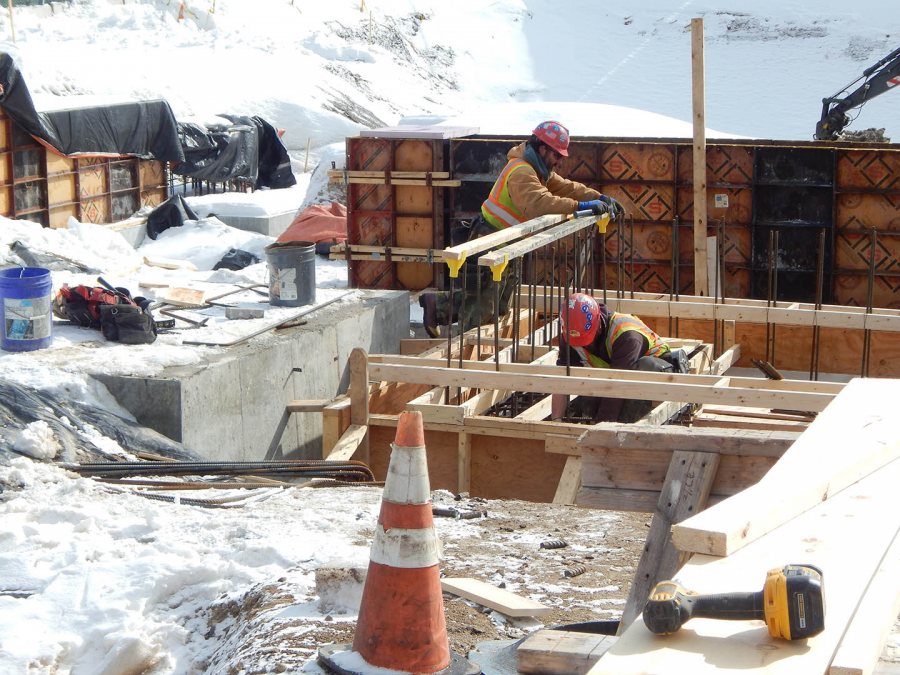
Campus Construction Update: March 6, 2015
If you really want to know how well your Geopiers or GeoConcrete Columns have stabilized ground that you want to build on, here’s a good way to load-test the soil:
Equip a heavy-duty hydraulic jack with a computerized load-measurement device — may we suggest a linear strain conversion transducer? — and base the jack on the patch of soil you want to test. Then mount a really heavy-duty frame or platform atop the jack.
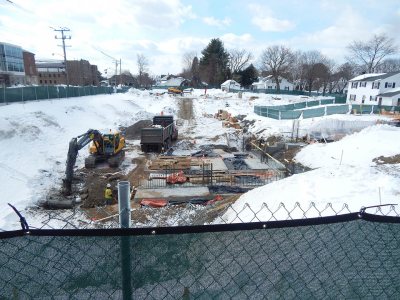
Foundation work in the basement of 65 Campus Ave., seen from the 8-foot ladder. (Doug Hubley/Bates College)
Finally, get your self-propelled drill rig back from the neighbor who borrowed it to sink his own GeoConcrete Columns and drive it onto the platform. Then check the computer to see how the soil responds to the weight.
All right, so there’s a little more to it than that.
But in February, Helical Drilling of Braintree, Massachusetts, did a lot of testing along those lines at the bottom of the hole that will hold the basement of the Campus Life Project’s 65 Campus Ave. construction site. The tests followed the implanting of 233 GeoConcrete Columns intended to bolster soil that will support the basement.
And the tests showed that the columns are doing the job.
That means that workers can start building that basement. And, with foundation work already well underway elsewhere on the 65 Campus Avenue site, as well as at 55 Campus Ave., the success of the GeoConcrete Columns means that the project management team can get the construction timetable for Bates’ two newest student residences back on track.
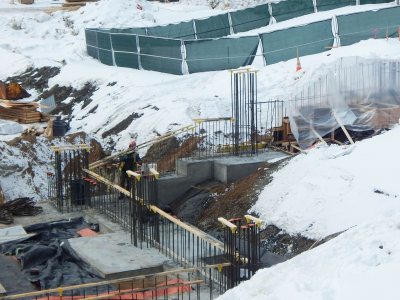
Foundation work extends down into the basement pit at 65 Campus Ave. on March 2, 2015. The vertical rebar forms will be piers to support columns. (Doug Hubley/Bates College)
That timetable was changed to adapt to the soil issues at 65 Campus. While the original plan was to concentrate on No. 65 till the foundations were done, the delay at the basement site prompted management to shift the foundation workers to 55 instead to keep them occupied and the work progressing.
But now foundation work on the basement is going full tilt — making amazing progress just this week. “They may end up working continuously on 55 Campus,” says Chris Streifel, Bates project manager for the residence construction, “but there may also be an interval here when they move back and focus purely on 65.”
“Then, once steel starts swinging, they’ll come back and finish foundations on 55.” That’s steel as in steel for the building’s skeleton, and we can watch for that in April.
The student residences planned for 55 and 65 will essentially sit on typical slab foundations. But “slab foundation” doesn’t quite capture the extent of the work involved, explains Streifel.
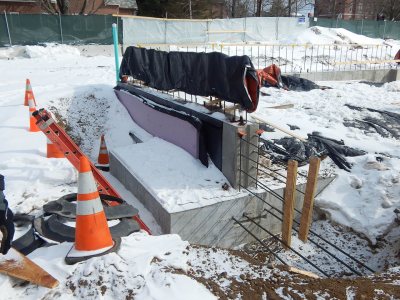
A wall foundation section sits on a spread footing at 65 Campus Ave. The black materials on the side of the concrete form are for moistureproofing. (Doug Hubley/Bates College)
At the root of it all are in-ground concrete creations called spread footings, so named because they are wider than the elements they support and therefore spread the weight around. (As opposed to throwing weight around, as Campus Construction Update likes to do here in the Bates Communications Office compound.)
Building walls rest on concrete sections that are in turn supported by spread footings. “You also have piers rising from footings where concentrated loads from columns will be placed,” Streifel says.
“So the wall sections will ultimately support the building walls, the piers will support loads typically associated with columns and the spread footings support it all.”
None of these footers, he adds, are small. For instance, some of the rebar skeletons for the column footers (rebar being the metal rods that help hold concrete together) are 10 by 10 feet.
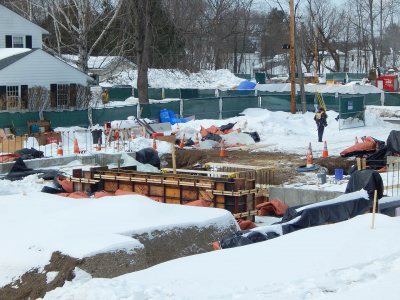
Wall foundation sections for the new student residence at 65 Campus Ave. The red-and-black tarp-like things are blankets that help concrete cure in the cold. (Doug Hubley/Bates College)
Recently there have been about 30 workers on the project between Consigli Construction, supervising the project for Bates, and subcontractors performing site and foundation work, according to Consigli project manager Tim Schneider. Occasionally a small crew from Standard Waterproofing of Waterville is on site as well, applying a variety of materials — all resembling black tarps — to seal against moisture and divert it from the concrete components.
So if you get your stepladder back from the neighbor who borrowed it, take it to either construction site, stand it in a snow bank and climb up to see over the fence — while playful March breezes tease your ears and fingers and put you in mind of Tahiti — you can see all these footers, piers and wall sections zigzagging in their wooden forms across the frozen earth, including the hole for the No. 65 basement.
You can also see the construction workers who have been on the site since December and probably stopped thinking about Tahiti around the 50th or 60th inch of snow.
Can we talk? Campus Construction Update welcomes your questions and comments about current, past and future construction at Bates. Write to dhubley@bates.edu, putting “Campus Construction” or “Tahiti! When?” in the subject line. Or use the 21st-century commenting system below.
